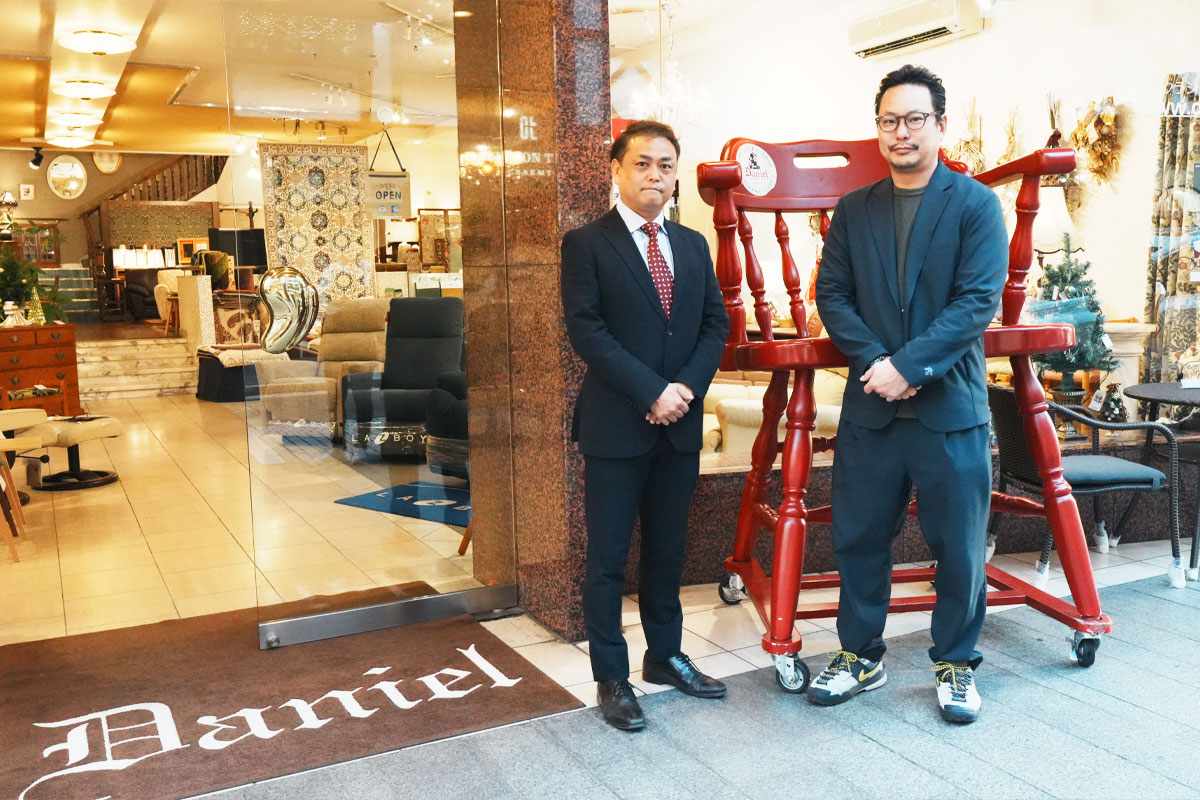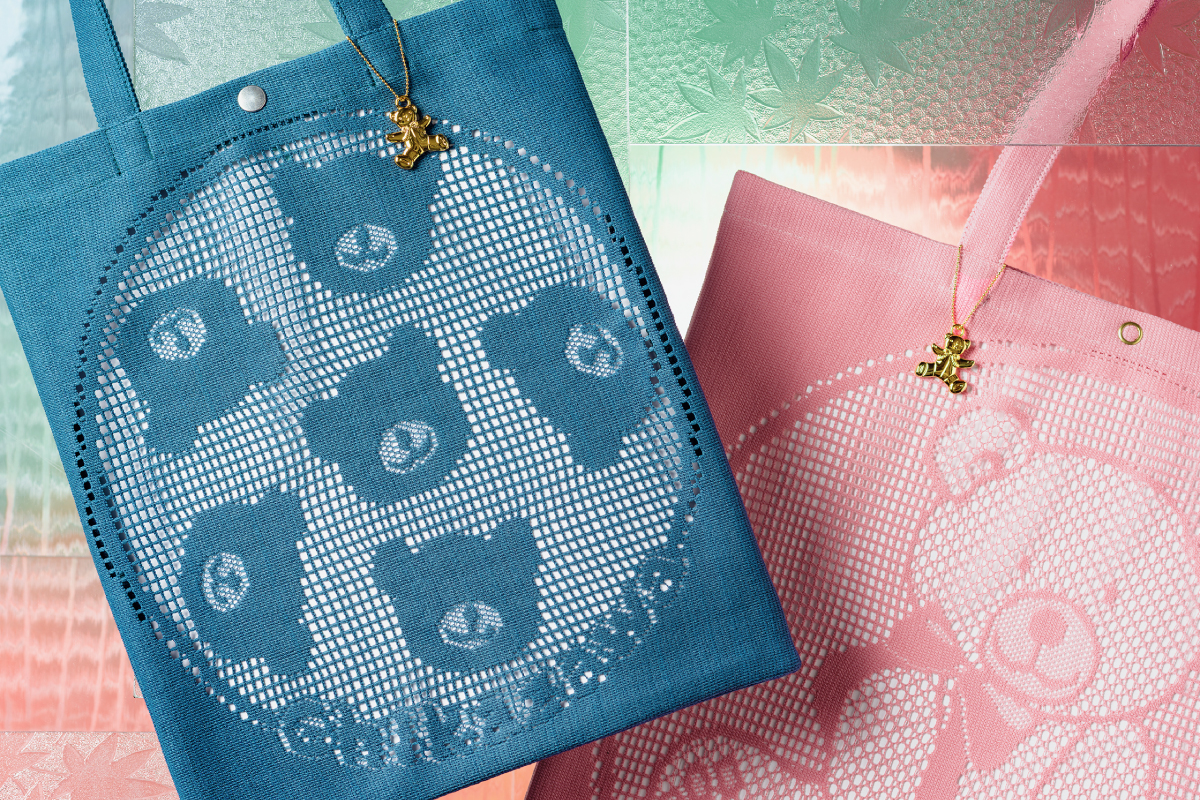連載|記憶を織る——ダイアン・クライス氏が語るアンティークレース物語
- コンテンツ
- 2025.07.31.
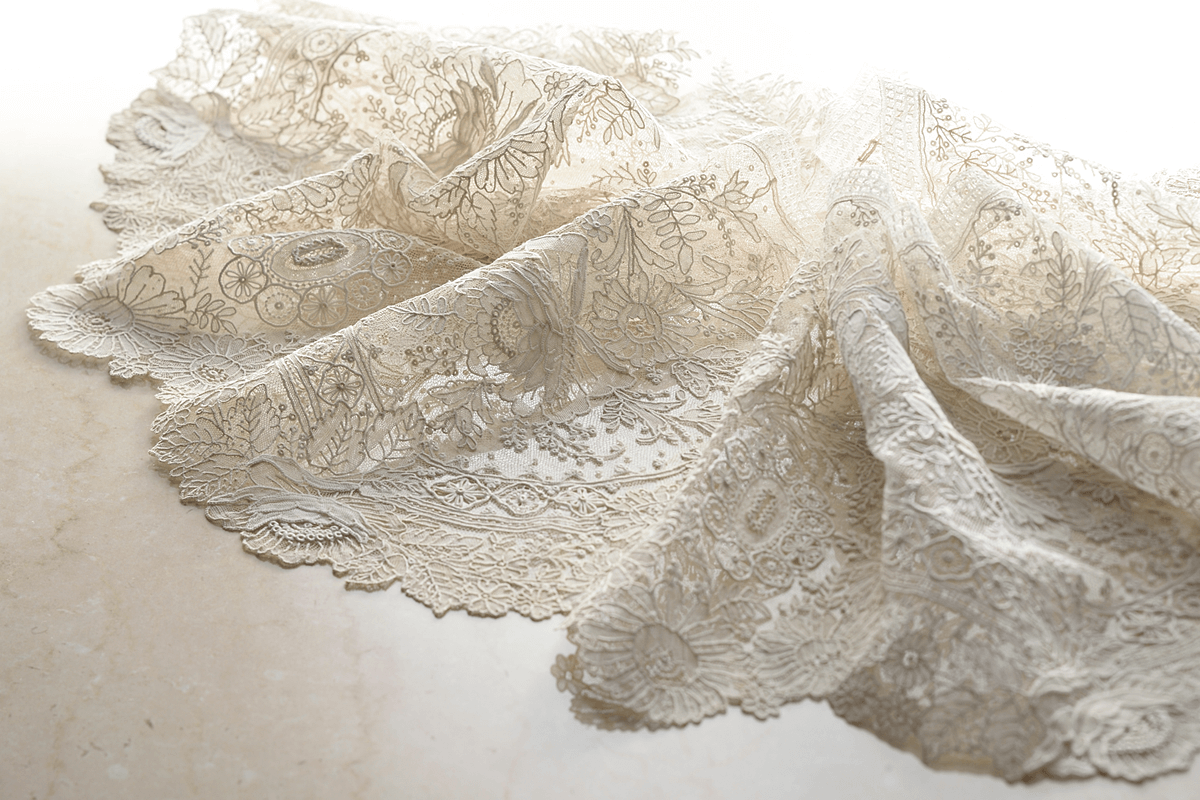
私たち近沢レース店は、横浜・元町の地にて、創業以来レースとともに歩んできました。
繊細な糸で描かれた模様には、祈りや祝福、そして美しさへの憧れが織り込まれています。レースはただの装飾ではなく、人生の節目に寄り添い、想いを託す存在でもあります。
本連載では、世界的なアンティークレース鑑定家であるダイアン・クライス氏の視点を通して、レースの奥深い魅力をひもといていきます。ベルギー・アントワープに生まれ、レースに囲まれて育った彼女は、コレクターとしてだけでなく、その文化的価値を未来へつなぐ語り手でもあります。
レースは静かに語りかけてきます。声なき物語に耳を澄ますことで、見えないものを想う心や、手間を惜しまない美意識が、そっと立ち現れてくるはずです。
レースを愛し、受け継いできた一人として、そしてこれからも伝えていきたいと願う一人として。私たちもまた、ダイアン氏とともに、その物語に耳を傾けていきたいと思います。
なぜ人はレースに惹かれるのか
レースとは、ただの織物ではありません。繊細な糸が描き出す模様のひとつひとつに、人々の祈りや祝福、そして美への憧れが織り込まれています。その小さな意匠の背後には、歴史があり、文化があり、誰かの人生があります。
レースに、人はなぜ惹かれるのでしょうか。それは、見た瞬間に「ただ美しい」と感じさせる圧倒的な視覚的魅力に加えて、その背景にある時間と手の記憶を、無意識のうちに感じ取っているからかもしれません。
目に見えない時間、目には触れられない想い。レースは、それらを糸の連なりで視覚化したものです。1本の糸が何百回、何千回と交差を繰り返しながら、まるで空気を編むように形作られるレース。
その緻密さは、ときに写真よりも雄弁に、持ち主の階級や時代、地域性、そして送り手の想いまでも語ってくれます。
だからこそ、レースとは単なる装飾ではなく、“語り手”であり、“記憶の器”であるといえるでしょう。
アンティークレース鑑定家 ダイアン・クライス

そんなレースに魅せられ、人生をかけてその世界を探求してきたのが、ダイアン・クライス氏です。
ベルギーの都市アントワープに生まれたダイアン氏は、祖母や母の代から受け継がれてきたレースに囲まれて育ちました。子ども時代の記憶の中には、繊細な模様をそっと広げ、光にかざして見せてくれる家族の手と、そこに息づく温もりが焼きついているといいます。
「レースは私にとって、常に“そこにあるもの”でした。でも大人になるにつれて、それが特別なものであり、忘れられつつある存在であることに気づいたんです」
大学では歴史や美術を学びながらも、心は常にレースへと向かっていた彼女。20代後半にはすでに本格的なレース収集をはじめ、研究のために図書館や博物館を訪ね歩く日々が続きました。
彼女が注目したのは、「誰が、なぜ、それを作ったのか」「なぜ、そこにそのモチーフが選ばれたのか」という点です。
作品の美しさだけでなく、その背後にある人間の営みや精神性に目を向けていったのです。
ダイアン氏独自の視点は徐々に評価され、やがて彼女のコレクションは国内外の展覧会で紹介されるようになります。現在では、ベルギー、フランス、イタリア、日本など複数の国と関わりをもちながら、レースの語り手/伝え手として活動しています。
祈りか、装飾か。アンティークレースの魅力

アンティークレースと呼ばれるものの多くは、16世紀末〜19世紀のヨーロッパで生まれました。当時のヨーロッパ社会では、織物は単なる布ではなく、権威・宗教・文化的教養を象徴するものとしての意味を担っていました。
その中でもレースは、階級を表す役割としての側面が強く、装飾性と象徴性を併せもつ特異な存在でした。
フランドル(現在のベルギー)やイタリア、フランスでは、王侯貴族や聖職者たちの襟や袖、祭壇布、婚礼衣装などにレースが多用されました。細かく繊細であればあるほど、手間と時間、つまり富と権力の象徴とされたのです。
技法もまた、地域と時代によって多種多様です。たとえば「ニードルレース」は、針と糸だけでレースを構築していく技法。刺繍とは異なり、布の上に縫うのではなく、空中に模様を編み上げるような独立した構造をもっています。
対して「ボビンレース」は、木製の糸巻き(ボビン)を数十本以上使って糸を交差させ、模様を織っていく方法。多くの手と集中力を必要とし、作業は数ヶ月、時には年単位に及びました。
素材にも物語があります。麻やリネン、絹はもちろんのこと、貴族階級では金銀糸を使った豪奢なレースも存在しました。それぞれの素材が放つ光沢や柔らかさが、レースの印象を決定づけ、着る者の品格や目的をも演出したのです。
レースはまた、ただの技術の結晶ではありません。職人たちは模様を単に装飾としてではなく、願いや祈りを込めた記号として編み込んできました。植物、動物、幾何学、宗教的シンボルなど。それらは一つひとつ、時代や地域の人々の想像力と信仰を物語っています。
レースに織り込まれた「意味」
模様には、意味があります。アンティークレースを眺めるとき、まず目を引くのはその美しい装飾ですが、そこに秘められた象徴性(シンボリズム)を読み解くことで、私たちはさらに深い文化の層に触れることができます。
たとえば葡萄。豊穣や祝祭の象徴であり、またキリスト教では「血」の意味をもつモチーフでもあります。あるいは鳩や鳥は、自由・魂・聖霊の象徴。リース(輪)は永遠や結びつき、愛の持続を意味することがあります。特定の植物、例えばリリー(百合)は純潔、バラは愛や受難、オリーブは平和を象徴します。
レースに編まれたこうしたモチーフは、時代や用途によって選び抜かれており、一枚の織物が、見えない言葉を語っているのです。
とりわけダイアン氏が注目しているのは、「同じモチーフでも、地域によって描き方が異なる」点です。
たとえばフランスの17世紀のレースでは、植物が写実的に描かれていたのに対し、18世紀のイタリアではより抽象的・装飾的に再構築されている。また、戦争や疫病の時代には、慰めや祈りを象徴する「天使」や「燭台」「祈りの手」が頻出し、そうした時代背景も模様に現れているといいます。
こうした象徴の蓄積こそが、アンティークレースを単なる手仕事の粋から、文化的記録物・精神の遺産へと昇華させているのです。
レースは、見た目の美しさの奥に、意味という名の物語を隠している。その声なき物語に耳を澄ませることができる人だけが、本当のレースの価値に触れられるのかもしれません。
レースと人生の節目
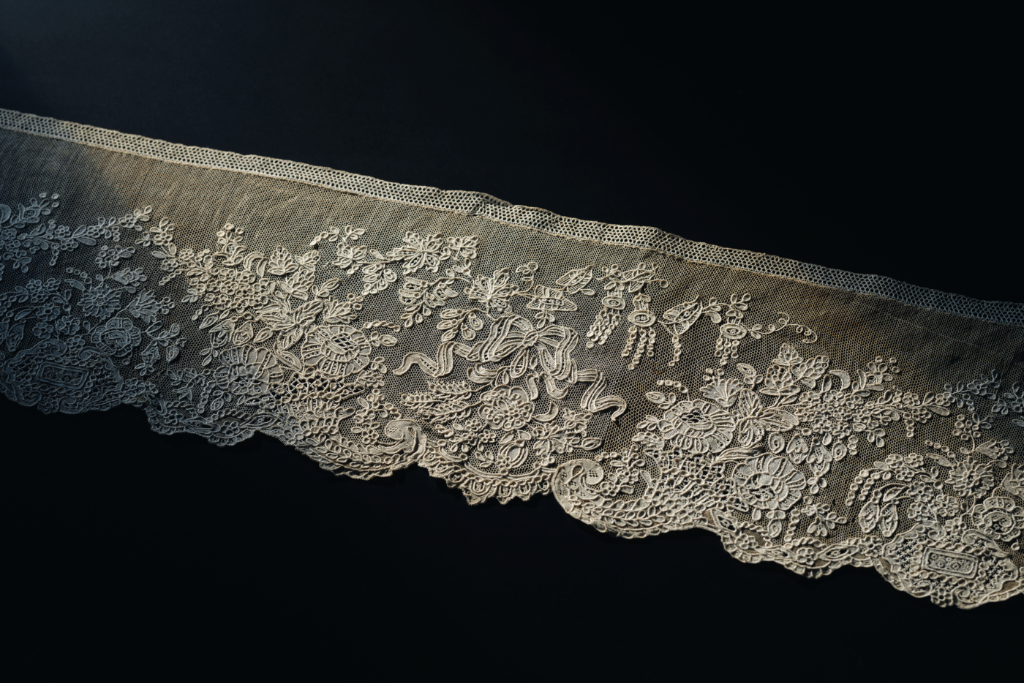
レースは、人生の節目を静かに彩ってきた存在でもあります。それは誕生や洗礼、結婚、そして別れの場面において、言葉以上の想いを託す「声なき贈り物」でした。
とりわけ結婚式は、レースと深い関係をもつ儀礼のひとつです。レースのヴェールは、新婦の純潔と神聖を象徴し、人生の新たな章への門出を包み込むものでした。
ヴェールに用いられるレースは、母や祖母から受け継がれることも多く、それは単なる装飾品ではなく、家族の記憶と愛情が織り込まれた織物そのものでした。
一方、誕生の場面では、洗礼のガウンや帽子に繊細なレースが使われることが多くあります。赤ん坊の無垢さと祝福を表す白い生地に、小さな葡萄や花のモチーフが刺繍されていることもあり、そこには「健やかな成長を願う」気持ちがこめられていました。
また、レースは死の儀礼にも寄り添ってきました。喪のレースは黒いシルクやクレープで作られ、悲しみと尊厳を表現するための静かな美をまとっています。そこには、祈りや見送る心が、糸の繊細さに反映されているようです。
レースには、人生の大切な場面を“目に見えるかたち”にする力があります。誰かを想う気持ちや、節目への敬意が、ひと目で伝わる。だから人はレースを手放さず、大切に保管し、次の世代へと託していくのでしょう。
ときには小さなレースの断片が、家族の記憶のすべてを代弁することもある。その織物は、時間を超えて、手渡される感情なのかもしれません。
ダイアン氏から見た日本
「初めて日本を訪れたとき、私は“布”が文化として生きている国だと感じました」
ダイアン氏はそう語りながら、日本に対する深い敬意を見せてくれます。彼女が日本に魅かれた理由のひとつは、素材へのまなざしのていねいさと、手仕事に対する哲学にありました。
友禅染や刺し子、裂織など、日本の伝統的な布文化には、布をただの消耗品にしない精神が息づいています。
一針一針に込められる想いや、布そのものを直しながら長く使い続ける文化。それは、レースという繊細な手工芸に対してダイアン氏が抱いている価値観と、深く共鳴するものでした。
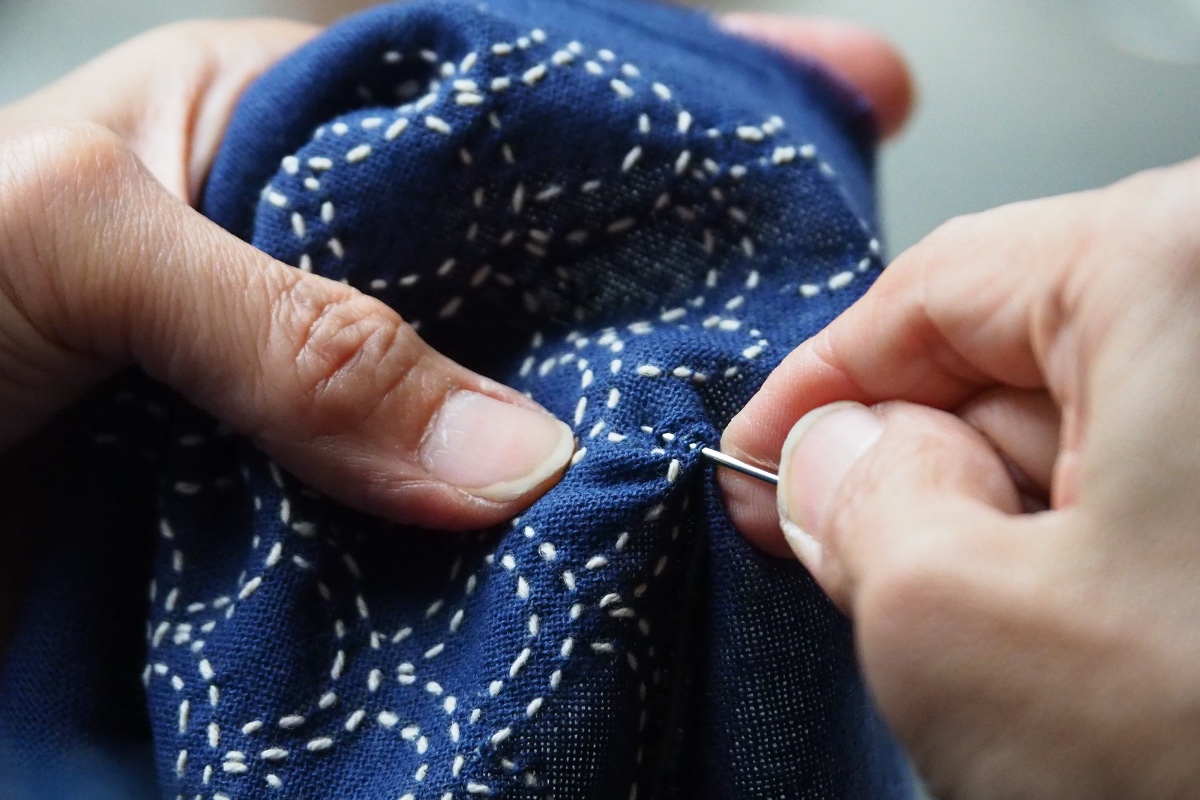
ダイアン氏が大切にしている「手仕事による文化の継承」という視点は、近沢レース店のものづくりとも深く通じるものがあります。
近沢レース店とダイアン・クライス氏の出会いは、今から10年以上前に遡ります。当時ベルギーを訪れた際、私たちは現地で、非常に上質なベルギーレースを取り扱っている一軒の店に出会いました。
当時、ベルギーレースといえば中国製のものが多く出回っており、本場の本格的なベルギーレースに出会えたのは、実はそのときが初めてのことでした。
そのお店を営んでいたのが、アンティークレース鑑定家のダイアン・クライス氏です。現在は店舗を閉じられましたが、あの出会いが私たちにとって、レースとの向き合い方をあらためて考えるきっかけとなりました。
文化が違えど、同じ手仕事で心が動く。ダイアン氏との交流は、国や言語を超えて“美しい美のかたち”が通じ合うことを証明してくれます。
レースを未来へつなぐために
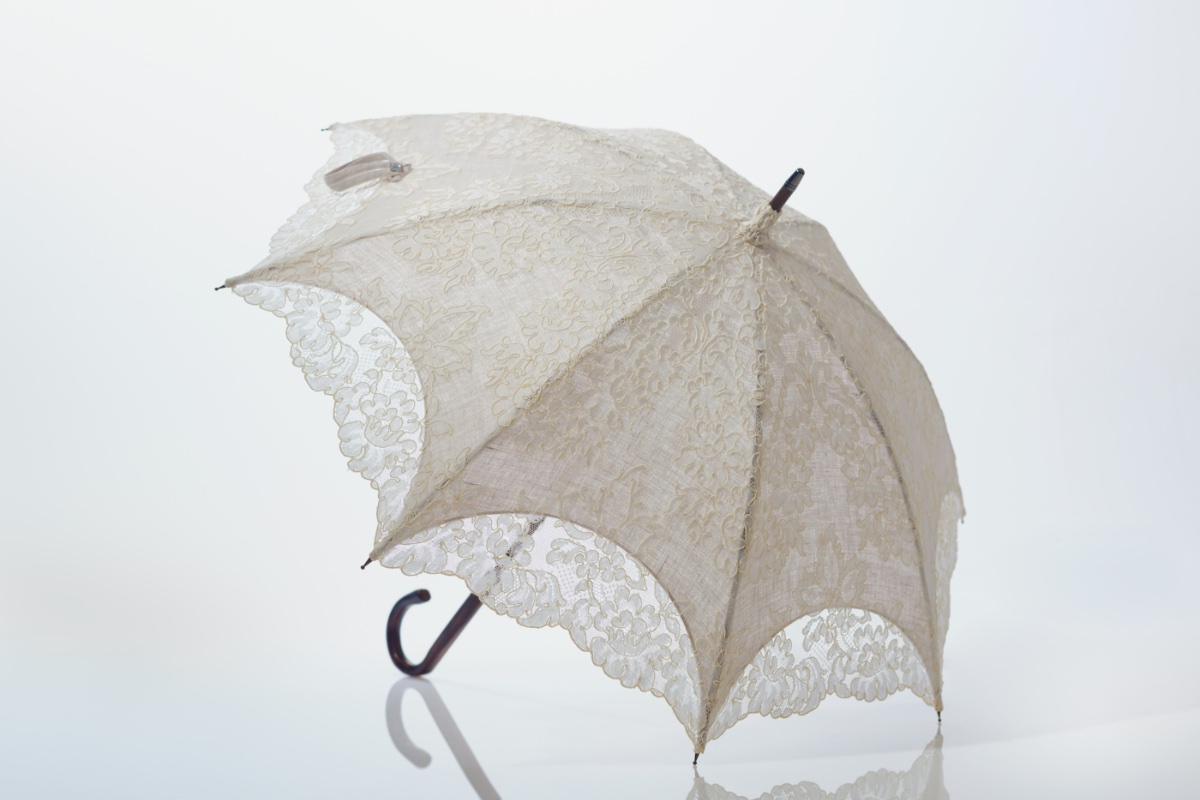
アンティークレースは、過去の記憶であると同時に、未来への問いかけでもあります。なぜなら、その繊細で豊かな文化が、今日なお確かな価値を保ちながら、なおも消えゆく危機に晒されているからです。
ダイアン氏は、自身のコレクションを収集品としてではなく、語るための資料として捉えています。レースを未来へつなぐには、それを単に保管するだけでなく、意味を読み解き、語り、共有する必要があると考えているのです。
彼女の活動は、展覧会の企画・監修だけにとどまりません。レースの保存状態を調べ、修復や記録方法の研究にも携わり、またコレクションの一部を公開するデジタルアーカイブプロジェクトにも関わっています。
そのすべてが、「レースを過去に閉じ込めず、生きた文化として次世代に手渡す」という志に根ざしています。
とりわけ、若い世代との接点をどう作るかは、彼女が最も関心を寄せている課題のひとつです。現代のファッションやデザインの中に、レースがどう息づくことができるか。テキスタイルアートや建築装飾との融合、素材としての再定義、デジタルとの掛け合わせ・・・
レースの技法や美学が、新たな文脈にどう位置づけられていくかは、これからの私たちに委ねられています。
「レースを守ることは、ただ古いものを保存することではありません。その奥にある、手間を惜しまないことの意味、無言の象徴を受けとる力を失わないために、必要なことなのです」
彼女のその言葉は、私たちが「美」というものをどう定義し、どこまで尊重しようとするか、という価値観への問いでもあるのでしょう。
近沢レース店もまた、レースを現代の暮らしにどう根づかせ、意味づけていくかという問いに、100年近く向き合ってきた存在です。その取り組みは、「日常に寄り添うレース」という新たな文脈を生み、レースを一部の装飾文化から、より多くの人が手にできる美のかたちへと開いてきました。
古くて新しい。儚くて、力強い。レースとは、そうした時間の層をまとった織物です。それをどのように受け継ぎ、次の時代へと橋渡ししていくか・・・
その営みにこそ、私たちの文化的成熟が問われているのかもしれません。
まとめ|レースの声に耳をすます
「レースは、語りかけてきます。私はその声に耳をすませ、その物語を拾い上げ、次の誰かに届けたいと思っているのです」
そう語るダイアン・クライス氏の声は、静かで深く、どこか祈るような響きを持っていました。
レースは織物でありながら、音をもたないメディアです。言葉も、音色も発さない。それでも、編み込まれたモチーフのひとつひとつが、無数の糸の重なりが、見る者の感覚に訴えかけてくる。
まるで、過去から手渡された手紙を、そっと読み解くような行為に似ています。
目に見えるものの奥に、目に見えないものがある。織物の上に表れた模様の背景に、無数の人生や社会の構造、信仰や願いが織り込まれている。レースとは、可視と不可視、静と動のあわいに存在する、美の沈黙なのかもしれません。
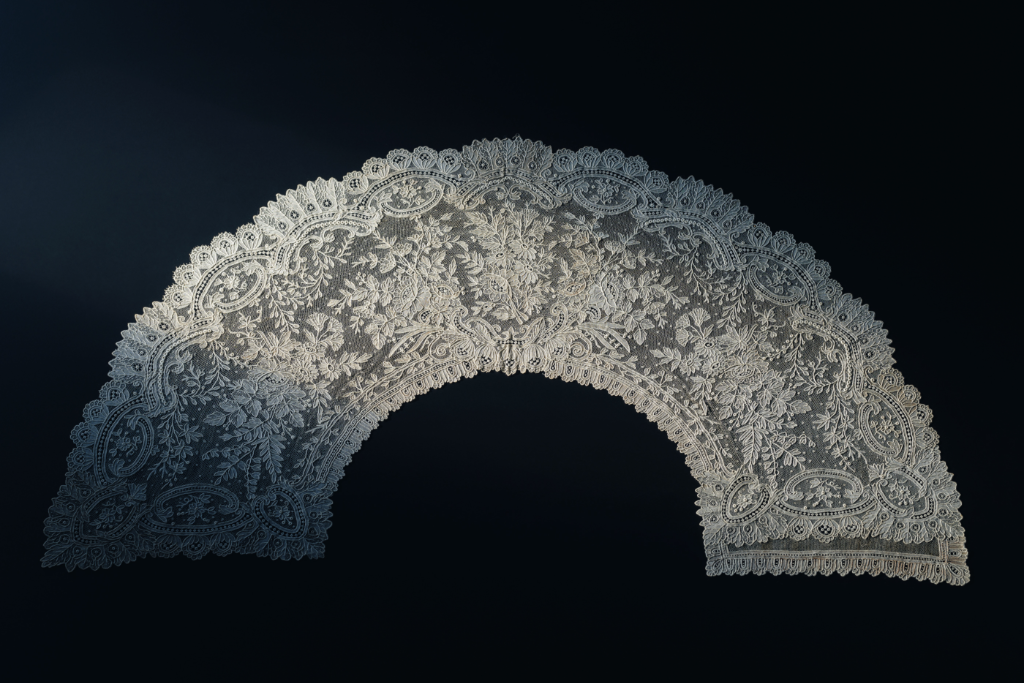
現代を生きる私たちは、スピードや効率を重視し、過剰な情報の中に身を置いています。そんな時代だからこそ、何も語らないレースの沈黙に耳をすますことが、私たちに“美意識”とは何かを問い直させてくれるのです。
そしてその問いは、決して過去の文化へのノスタルジーではありません。未来に美しさをつなぐための、確かな一歩なのです。
今後も、ダイアン・クライス氏の豊かなコレクションと思想をもとに、レースが語る歴史や文化、美学の深淵を、ひとつひとつ丁寧に紐解いていきます。
次回からは、アンティークレースの歴史を紐解いていきます。レースが誕生した背景や、その社会的役割についてご紹介します。
時代とともに変化しながらも、人々の心に寄り添ってきたレースの軌跡を、ぜひご一緒に辿っていただければ幸いでございます。
Weaving Memory: The Silent Stories of Antique Lace
Lace is more than just fabric.
Each motif, meticulously drawn by fine threads, embodies prayers, celebrations, and a yearning for beauty. Behind these delicate designs lie histories, cultures, and the lives of those who came before us.
Why are we so drawn to lace?
Perhaps it is not only the breathtaking visual appeal, but also the unconscious recognition of the time and hands that brought it into being.
Lace gives form to the invisible — the flow of time, silent emotions — rendering them in patterns of thread. One strand may cross hundreds or thousands of times, as if weaving air itself. In its intricacy, lace can speak more eloquently than photographs, revealing class, era, region, and even the sentiment of its giver.
This is why lace is not merely decoration. It is fabric that speaks — a vessel of memory.
Why Are We Drawn to Lace?
Lace is more than just fabric. Each delicate pattern spun from fine threads carries with it prayers, blessings, and an enduring longing for beauty. Behind even the smallest motif lie histories, cultures, and someone’s personal story.
Why are we so captivated by lace? Perhaps because, beyond its visual allure, we sense the weight of time and the memory of human hands woven into its form. Lace embodies that which is invisible — emotion, ritual, memory — and gives it shape. One thread crosses another hundreds, even thousands of times, forming patterns as if weaving air itself.
Its intricacy often speaks more eloquently than photographs, telling of a wearer’s class, the era they lived in, the region they came from, and even the sentiments of the person who gave the lace.
That is why lace is not merely a decorative textile — it is a “speaking cloth,” a vessel of memory. In moments of birth, baptism, marriage, and farewell, lace has quietly adorned life’s milestones, carrying more meaning than words could express. It has long served as a silent gift — one that conveys love, respect, and remembrance across generations.
Diane Claeys — A Life Devoted to Lace
For decades, Diane Claeys has devoted herself to the study, collection, and preservation of antique lace. Based in Belgium, she is known internationally as one of the most respected connoisseurs in the field, possessing deep expertise that bridges history, artistry, and cultural heritage.
Her fascination with lace began in childhood. Captivated by the intricate patterns and the lives they hinted at, she pursued this passion with unwavering dedication. Her collection now includes thousands of rare and historic pieces — lace that once adorned queens, clergy, and aristocrats; lace that served as both ornament and message.
But Diane’s true gift lies not only in collecting, but in interpreting. She reads lace like a text, drawing out the voices hidden within its threads. To her, each piece is a cultural document — one that reveals how people lived, what they valued, and how they expressed emotion when words fell short.
Her work goes beyond academia or antiquarian interest. It is a mission to ensure that the stories embedded in lace are not lost to time, but continue to speak to future generations.
WhyOrnament or Offering? The Allure of Antique Lace
Antique lace is a medium where beauty and meaning are interwoven. In 16th- and 17th-century Europe, lace first flourished in churches and on royal garments. It was not mere ornamentation but a textile of profound symbolism—used to honor the sacred, to express wealth and power, and sometimes, to veil a person’s inner state with elegance and grace.
It is said that lace began as a form of devotion. Intricate needle lace was offered in place of gold and jewels by women who could not afford such riches. The time and care spent on each stitch were, in themselves, a prayer. What once adorned altars and clergy garments later made its way into aristocratic fashion and home décor, becoming a symbol of status and refinement.
But even as lace transitioned from religious ritual to secular beauty, it never lost its power to convey emotion. In mourning, for example, lace continued to play a role. Black silk and crepe lace expressed silent sorrow and dignity. One can feel the quiet presence of farewell and remembrance in the softness of each thread.
In this way, lace has served as a textile of emotion—sometimes joyful, sometimes solemn. It is both decoration and devotion, beauty and message.
Inheriting Memory Through the Thread of Lace
Lace is more than just a decorative fabric—it is a vessel for memory, passed silently from one hand to the next. In earlier times, it marked life’s most intimate milestones: birth, baptism, first communion, marriage, and even mourning. Carefully stored in drawers or family chests, lace was a “silent gift” entrusted with emotion too profound for words.
A piece of lace might accompany a newborn’s breath, adorn a bride at the altar, or be held in a mourner’s hands at a graveside. Over time, even as the memories of those moments fade, the lace remains, holding traces of those feelings in its delicate form. Its fragility is a reminder of human tenderness, its endurance a testament to care and intention.
Diane Claeys often speaks of lace as “an emotional fabric.” Not because it is inherently sentimental, but because it retains the intentions of its maker and bearer. One fragment of lace can evoke an entire family history. In this way, lace transcends time—not as an artifact, but as an heirloom of the heart.
To inherit lace is to inherit the lives and hands that touched it. It is to hold, however briefly, the invisible threads that connect generations.
A Country Where Fabric Lives as Culture
“When I first visited Japan, I sensed that ‘fabric’ was alive as a part of the culture,” Diane Claeys recalls.
What captivated her was not just the beauty of traditional textiles like yuzen-dyeing, sashiko stitching, or sakiori weaving—but the reverence shown to cloth itself. The Japanese spirit of craftsmanship cherishes the process as much as the product, honoring the act of mending and prolonging a fabric’s life rather than discarding it. To Diane, this respect for material echoed her own beliefs as a lace collector and historian.
In Japan, cloth is never treated merely as a disposable object. Every needle prick, every handwoven thread, carries intention. This cultural mindset aligns deeply with Diane’s view of lace as a form of living heritage—something to be protected, understood, and cherished beyond its aesthetic value.
Her respect for Japan grew stronger through her encounters with Chikazawa Lace. More than ten years ago, a chance meeting in Belgium led to a memorable discovery: a shop carrying genuine, high-quality Belgian lace—a rarity even in its place of origin, where imitation goods had become the norm. That shop was run by none other than Diane Cleays herself.
It was there that the seeds of connection were sown. Diane saw in Chikazawa Lace a rare spirit—an unwavering commitment to keeping lace alive not through mass production, but through the discernment of the hand and the eye.
“Some things can only be born through the hand. It is the people who still believe in that truth who keep lace alive,” she says. “Chikazawa Lace is a living testament to that spirit.”
Different cultures, different languages—yet a shared reverence for beauty. Diane’s gaze proves that across borders, the fabric of emotion can still be understood.
“To speak of lace is to speak of human encounters through cloth.”
Her words are quiet, yet profoundly sincere.
Handing Lace to the Future
What does it mean to preserve lace?
Diane Claeys offers a thoughtful answer: “It’s not simply about saving something old. Preserving lace means not losing the ability to appreciate what is quiet, what is symbolically rich, what was made with care.”
She is deeply concerned that as our lives grow faster and more efficient, we risk losing the sensibility to value what cannot be mass-produced. Lace, with its intricate slowness and unspoken meaning, asks us to slow down. It asks us to feel.
In her view, lace should not be confined to glass cases in museums. While she acknowledges the importance of academic preservation, she believes lace belongs in life. It should be touched, worn, handed down—not only studied. “A piece of lace tells a different story when it’s alive in someone’s everyday life,” she says.
That is why she feels a strong kinship with Chikazawa Lace. The company is not only preserving lace—it is making lace relevant. By incorporating fine lace into everyday objects such as handkerchiefs, it invites people to experience the beauty of lace as part of their lives. It breathes life into tradition.
“To preserve lace is to protect the language of the hand,” Diane says. “That language speaks of care, connection, and time.”
For Diane, the goal is not to lock lace in the past. It is to keep it whispering to the present—and to the generations to come.
コンテンツ一覧
Contents
- コンテンツ
- 2025.12.20.
近沢レース店のレーストートの歴史。10年のデザイン進化に迫る!
- コンテンツ
- 2025.12.01.
